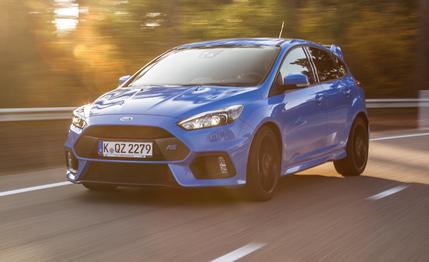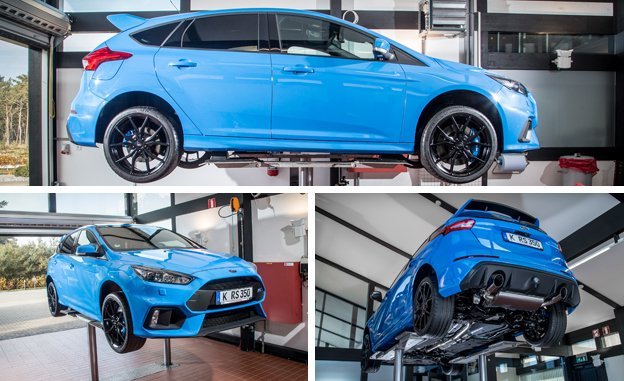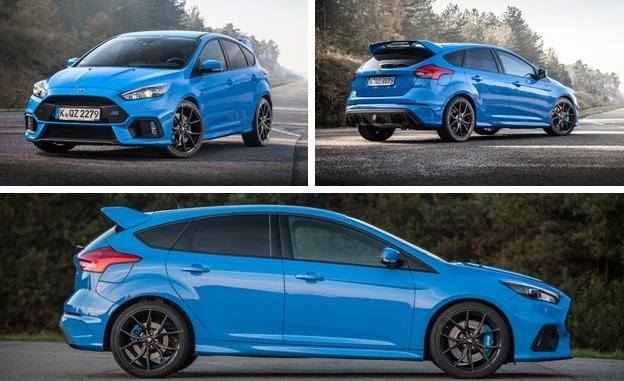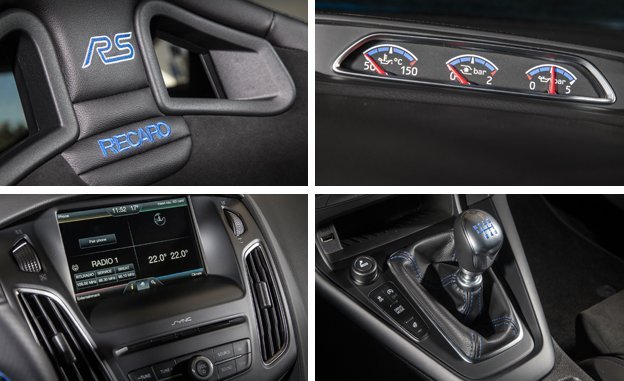 First Drive Review
First Drive Review
The Ford Focus RS is a car that needs little introduction. Ford has been hyping its all-wheel-drive hatchback for pretty much a full year, most recently with a viral video campaign featuring more episodes than many HBO dramas. Like the two previous Focus RS models, it has been engineered primarily in Europe; unlike the earlier cars, it will be sold around the world, including the U.S., where its $36,605 MSRP puts it in direct competition with the Volkswagen Golf R and the Subaru WRX STI. This is uncharted territory for Ford.
Our drive takes place at Ford’s test track at Lommel, Belgium, in the most boring corner of Europe’s most boring country. The camo-clad prototypes of other vehicles have been banished for the day and we have practically full reign of the place, which includes more than 50 miles of tracks that range from a high-speed oval with banked turns to Route 7, a dynamic course that incorporates replicas of senior Ford engineers’ favorite real-world corners.

The first and most obvious point when inspecting the RS up close is how familiar it looks. Yes, the body kit has a bit more muscular definition than that of the Focus ST, and the rear wing is bigger and the front air vents enlarged (and covered with motorsport-style mesh). But could you tell the two hot Focuses apart from across a dark street at night? Probably not. It’s the same story in the cabin, with some RS graphics and blue trim, plus the red zone of the rev counter sitting fractionally higher. But other than that, and a control panel for the four switchable driving modes next to the gear selector, very little has changed.
After a brief turn in the passenger seat, while a senior Ford engineer attempts to acquaint us with the track and reacquaint us with our breakfast as he demonstrates the impressive levels of lateral acceleration the RS is capable of generating, it’s time to take over.
Our first instinct—as we imagine yours would be—is to thrash the RS like a stolen donkey during our too-brief time behind the wheel. But with the same senior Ford engineer now sitting shotgun, and the sight of another RS prototype buried deep in a gravel trap serving as evidence of how slippery the track gets in the Belgian perma-rain, we opt to start at a more cautious pace.
The first question is answered within 100 yards of leaving the parking lot, that being whether the RS’s engine feels different from that of the Mustang EcoBoost. The two cars share what’s basically the same unit, although it has been turned sideways in the RS. The hatch also gets a more powerful twin-scroll turbocharger and various internal modifications to handle the increased boost pressure that delivers its headline-making 350 horsepower. (Read our full tech deep dive here.) It feels far more enthusiastic than the Mustang, with none of that car’s top-end tightness; there’s some lag down low, but the RS’s engine pulls hard once the turbo spins up and exhibits an undiminished zeal all the way to the 6800-rpm fuel cutoff.

The power delivery is strange in an era when carmakers seem determined to do all they can to hide the boosted nature of forced induction, but you soon get used to the excitement it brings. There’s something refreshingly honest about it; while the RS feels brawnier and has much more linear throttle response than an early Impreza WRX STI or Mitsubishi Lancer Evo, there’s something akin to the same spirit at play here. And that’s meant as a compliment.
At everyday speeds, the RS feels very similar to the ST. The big dynamic difference is the fixed-ratio steering in place of the ST’s ultraquick variable-ratio system, which makes initial responses seem slightly more sluggish. The six-speed manual gearbox feels pretty much identical to that in the Focus ST, with a nice weight and action. Ride quality is slightly firmer—adjustable dampers come as standard—and the exhaust note has a harder edge.
Adding velocity reveals greater differentiation, waking up the chassis and bringing the clever rear axle into play. It uses separate fast-acting, Haldex-style clutches for each rear wheel, allowing different amounts of torque to be directed to each side to help with vectoring or to effectively replicate a conventional limited-slip differential. Up to 70 percent of torque can be sent to the rear, and 100 percent of that figure can then be shunted to either side.
Upping the pace on Lommel’s longer corners demonstrates that, at the point when the front end of a Focus ST would start to run wide, the RS’s clever rear end starts to help out and bring the car back onto your chosen line. The rear wheels are driven slightly faster than the fronts under hard cornering, creating some of the same sense of edginess you get in a powerful rear-drive car. Push beyond this dynamic sweet spot and what happens next depends on which of the driving modes is selected. In Normal, the RS tries to stay as neutral as Belgium itself, while Sport allows a hint of drift from the rear. Track permits some well-contained power oversteer.

What if that’s not enough? What if you want the full Ken Block? Well, this brings us to the much-vaunted “drift mode,” a feature that, when Ford announced it, pretty much set the internet on fire. Ford won’t let us play with this on the road-aping parts of Lommel’s various courses, so instead we experience it on one of the vast tarmac lakes at the facility. After engaging drift mode via the selector, all that’s necessary is to apply an inappropriate ratio of steering lock and throttle pedal at the same time. There’s some initial “are you sure about this?” understeer, acting as a sort of dynamic liability waiver, and then, as most of the engine’s output is transferred to the outside rear tire, a transition into smoking oversteer.
It’s a neat trick, but it is just a trick. The RS can be made to practically spin in its own length if you’re so minded, but at higher speeds the system works to limit the angle of the drift—denying the sort of two-turn opposite lock that encourages the most purple automotive prose—with the stability system intervening by pinging the front brakes to help keep the RS on course. It’s surprisingly hard to hold a slide for more than a couple of seconds, although we suspect this will be enough for most owners.
On a Belgian test track the Focus RS is brilliant. Now all we need to wait for is to discover how the hottest Focus will deal with the world outside Lommel’s carefully honed simulation of it. The RS lacks the crude charm that earned its predecessors their cult following in Europe, with Ford’s global ambitions for this car clearly reflected in the fact that it’s vastly more accomplished. Ford has been building RS models for nearly five decades, and Americans have been lobbying for them for nearly as long. The first one to officially cross the Atlantic may be one of the best.